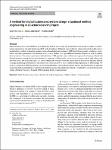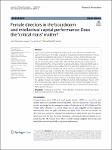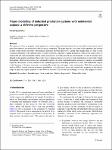Search
Author
- Osman, Ahmed I. (5)
- Daqing, Ma (3)
- Jorgensen, Ed (3)
- Li, Yan (3)
- next >
Subject
- kinh tế (26)
- Economics (12)
- programming (10)
- XRD (10)
- next >
Date issued
- 2020 - 2025 (2128)
- 2010 - 2019 (129)
- 2000 - 2009 (9)
- 1999 - 1999 (1)
Has File(s)
Search Results
Digital business ecosystem (DBE) is a paradigm that enables developing and monitoring novel business models of collaborating organisations and individuals using ICT as the foundation. Different from traditional online networked models such as manufacturer, retailer, or franchise centred, using a shared digital environment, DBE fosters heterogeneity, symbiosis, coevolution, and self-organisation of its multiple actors, which enables it to span different business domains as well as exhibits diverse interests. For many organisations and individuals, DBE presents a new collaborative approach to leverage offered and desired resources among the involved members to meet each of their goals. |
We introduce Neural Network (NN for short) approximation architectures for the numerical solution of Boundary Integral Equations (BIEs for short). We exemplify the proposed NN approach for the boundary reduction of the potential problem in two spatial dimensions. We adopt a Galerkin formulation-based method, in polygonal domains with a finite number of straight sides. Trial spaces used in the Galerkin discretization of the BIEs are built by using NNs that, in turn, employ the so-called Rectified Linear Units (ReLU) as the underlying activation function. The ReLU-NNs used to approximate the solutions to the BIEs depend nonlinearly on the parameters characterizing the NNs themselves. |
Classical music, unlike popular music, is usually recorded live with close microphone techniques. For this reason, isolated tracks are not available to create the final mixture/stream, and so the mixing process requires greater effort. Source separation methods are a potential solution to this problem. However, current algorithms are not fast enough to yield real-time separation in professional setups with dozens of microphones and sources. In this paper, we propose a fast approach consisting of a panning-based multichannel non-negative matrix factorization model to separate classical music. We tested the system on real professional recordings, where we were able to reach real-time with very low latency and promising quality. |
This research aims to investigate the influence of female directors on Intellectual Capital Performance (ICP) using a sample of manufacturing-listed companies in China. Our study investigates the link between having two or more female directors and the Modified Value-Added Intellectual Coefficient (MVAIC) methodology, employing the critical mass theory from 2004–2017. We find that having a critical mass of female directors (three or more) shows a significant positive impact on MVAIC and its components, including human capital efficiency, structural capital efficiency, relational capital efficiency, and physical capital efficiency, with physical capital being the critical driver. |
The question of how to properly model production systems with unintended outputs has proven both controversial and of particular interest to the productivity and efficiency community. The paper explains why some of the arguments put forward in these controversies are hardly convincing for industrial and other processes. Among other things, there is a lack of clear conceptual labelling of the different types of joint production, especially coupled production, which is the main source of undesirable and other unintended outputs, unless neglected. It is largely ignored that the desirability of such by-products may depend on the quantity produced. |
Derivatives with respect to the parameters of the integral Mittag-Leffler function and the integral Wright function, recently introduced by us, are calculated. These derivatives can be expressed in the form of infinite sums of quotients of the digamma and gamma functions. In some particular cases, these infinite sums are calculated in closed-form with the help of MATHEMATICA. However, parameter differentiation reduction formulas are explicitly derived in order to check some of the results given by MATHEMATICA, as well as to provide many other new results. |
This open access book, published to mark the 15th anniversary of the International Software Quality Institute (iSQI), is intended to raise the profile of software testers and their profession. It gathers contributions by respected software testing experts in order to highlight the state of the art as well as future challenges and trends. In addition, it covers current and emerging technologies like test automation, DevOps, and artificial intelligence methodologies used for software testing, before taking a look into the future. The contributing authors answer questions like: "How is the profession of tester currently changing? What should testers be prepared for in the years to come, and what skills will the next generation need? What opportunities are available for further training... |
Preparing today's students to be effective leaders in their professional lives requires that they hone their cultural intelligence as it is vital to working inter- and intra-culturally in today's global economy. This unique ability to identify, recognize, and acknowledge the differences and similarities that exist between and among cultural groups and systems will set their leadership skills apart from the masses. And when applied, cultural intelligence can bridge the gap in cultural misunderstanding by creating awareness, knowledge, and patience of cultural norms and behaviors. |
This open access book constitutes the refereed proceedings of the 5th Asian Supercomputing Conference, SCFA 2019, held in Singapore in March 2019.
The 6 full papers presented in this book were carefully reviewed and selected from 33 submissions. They cover a range of topics including memory fault handling, linear algebra, image processing, heterogeneous computing, resource usage prediction, and data caching. |










